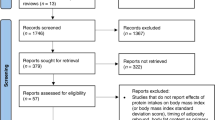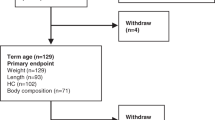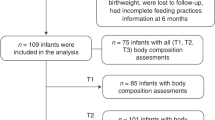Abstract
Background/Objectives:
High protein intake has been associated with increased growth. This may be linked to increased concentrations of insulin-like growth factor I (IGF-I), which seems to be influenced by the diet, especially its protein component. The short-term effects of high protein intake in late infancy are not known. The objective was to investigate the effects of high protein intake in the form of whole milk (WM) on growth and IGF-I from 9 to 12 months of age.
Subjects/Methods:
Healthy infants (n=83) were randomized to receive either WM or infant formula and fish oil or no fish oil (2 × 2 design). Anthropometric variables, IGF-I concentrations, serum urea nitrogen (SUN) and diet were recorded before and after the intervention.
Results:
Intake of WM significantly increased the protein energy percentage (PE%; P⩽0.001) and SUN (P=0.01), whereas there was no effect on size. The milk intervention increased IGF-I in boys (P=0.034) but not in girls. Intake of fish oil had no effect on the outcomes. Including all infants in the analysis there was a significant correlation between weight and IGF-I at 12 months (r=0.316, P=0.017), and PE% was positively associated with IGF-I after adjusting for sex and breastfeeding at both 9 (r=0.329, P=0.015) and 12 months (r=0.272, P=0.044).
Conclusions:
Randomization to WM had no overall effect on growth. However, the positive effect of WM on IGF-I in boys and the positive association between PE% intake and IGF-I at 9 and 12 months is consistent with the hypothesis that a high milk intake stimulates growth.
This is a preview of subscription content, access via your institution
Access options
Subscribe to this journal
Receive 12 print issues and online access
$259.00 per year
only $21.58 per issue
Buy this article
- Purchase on Springer Link
- Instant access to full article PDF
Prices may be subject to local taxes which are calculated during checkout



Similar content being viewed by others
References
Agostoni C, Grandi F, Gianni ML, Silano M, Torcoletti M, Giovannini M et al. (1999). Growth patterns of breast fed and formula fed infants in the first 12 months of life: an Italian study. Arch Dis Child 81, 395–399.
Agostoni C, Scaglioni S, Ghisleni D, Verduci E, Giovannini M, Riva E (2005). How much protein is safe? Int J Obes (Lond) 29 (Suppl 2), S8–S13.
Axelsson I, Borulf S, Raiha N (1987). Protein intake during weaning. II. Metabolic responses. Acta Paediatr Scand 76, 457–462.
Axelsson I, Gebre-Medhin M, Hernell O, Jakobsonn I, Michaelsen KF, Samuelson G (1999). [Recommendations for prevention of iron deficiency. Delay cow's milk intake as a beverage to infants until 10–12 months of age!]. Lakartidningen 96, 2206–2208.
Axelsson IE, Ivarsson SA, Raiha NC (1989). Protein intake in early infancy: effects on plasma amino acid concentrations, insulin metabolism, and growth. Pediatr Res 26, 614–617.
Bang P, Eriksson U, Sara V, Wivall IL, Hall K (1991). Comparison of acid ethanol extraction and acid gel filtration prior to IGF-I and IGF-II radioimmunoassays: improvement of determinations in acid ethanol extracts by the use of truncated IGF-I as radioligand. Acta Endocrinol (Copenh) 124, 620–629.
Bereket A, Turan S, Omar A, Berber M, Ozen A, Akbenlioglu C et al. (2006). Serum IGF-I and IGFBP-3 levels of Turkish children during childhood and adolescence: establishment of reference ranges with emphasis on puberty. Horm Res 65, 96–105.
Canadian Paediatric Society (2005). Dieticians of Canada and Health Canada: Nutrition for Healthy Term Infants. Minister of Public Works and Government Services: Ottawa.
Chellakooty M, Juul A, Boisen KA, Damgaard IN, Kai CM, Schmidt IM et al. (2006). A prospective study of serum insulin-like growth factor I (IGF-I) and IGF-binding protein-3 in 942 healthy infants: associations with birth weight, gender, growth velocity, and breastfeeding. J Clin Endocrinol Metab 91, 820–826.
Clemmons DR, Seek MM, Underwood LE (1985). Supplemental essential amino acids augment the somatomedin-C/insulin-like growth factor I response to refeeding after fasting. Metabolism 34, 391–395.
Cooke RJ, Griffin IJ, McCormick K, Wells JC, Smith JS, Robinson SJ et al. (1998). Feeding preterm infants after hospital discharge: effect of dietary manipulation on nutrient intake and growth. Pediatr Res 43, 355–360.
Damsgaard CT, Schack-Nielsen L, Michaelsen KF, Fruekilde MB, Hels O, Lauritzen L (2006). Fish oil affects blood pressure and the plasma lipid profile in healthy Danish infants. J Nutr 136, 94–99.
Dardevet D, Manin M, Balage M, Sornet C, Grizard J (1991). Influence of low- and high-protein diets on insulin and insulin-like growth factor-1 binding to skeletal muscle and liver in the growing rat. Br J Nutr 65, 47–60.
Dewey KG, Heinig MJ, Nommsen LA, Peerson JM, Lonnerdal B (1992). Growth of breast-fed and formula-fed infants from 0 to 18 months: the DARLING Study. Pediatrics 89, 1035–1041.
Dewey KG, Heinig MJ, Nommsen LA, Peerson JM, Lonnerdal B (1993). Breast-fed infants are leaner than formula-fed infants at 1 y of age: the DARLING study. Am J Clin Nutr 57, 140–145.
Dewey KG, Peerson JM, Brown KH, Krebs NF, Michaelsen KF, Persson LA et al. (1995). Growth of breast-fed infants deviates from current reference data: a pooled analysis of US, Canadian, and European data sets. World Health Organization Working Group on Infant Growth. Pediatrics 96, 495–503.
Dorosty AR, Emmett PM, Cowin S, Reilly JJ (2000). Factors associated with early adiposity rebound. ALSPAC Study Team. Pediatrics 105, 1115–1118.
Eriksson J, Forsen T, Tuomilehto J, Osmond C, Barker D (2001). Size at birth, childhood growth and obesity in adult life. Int J Obes Relat Metab Disord 25, 735–740.
Eriksson JG, Forsen TJ, Osmond C, Barker DJ (2003). Pathways of infant and childhood growth that lead to type 2 diabetes. Diabetes Care 26, 3006–3010.
Fall CH, Clark PM, Hindmarsh PC, Clayton PE, Shiell AW, Law CM (2000). Urinary GH and IGF-I excretion in nine year-old children: relation to sex, current size and size at birth. Clin Endocrinol (Oxf) 53, 69–76.
Garnett S, Cowell CT, Bradford D, Lee J, Tao C, Petrauskas V et al. (1999). Effects of gender, body composition and birth size on IGF-I in 7- and 8-year-old children. Horm Res 52, 221–229.
Gunnarsdottir I, Thorsdottir I (2003). Relationship between growth and feeding in infancy and body mass index at the age of 6 years. Int J Obes Relat Metab Disord 27, 1523–1527.
Gunther AL, Buyken AE, Kroke A (2007). Protein intake during the period of complementary feeding and early childhood and the association with body mass index and percentage body fat at 7 y of age. Am J Clin Nutr 85, 1626–1633.
Heaney RP, Davies KM, Barger-Lux MJ (2002). Calcium and weight: clinical studies. J Am Coll Nutr 21, 152S–155S.
Heinig MJ, Nommsen LA, Peerson JM, Lonnerdal B, Dewey KG (1993). Energy and protein intakes of breast-fed and formula-fed infants during the first year of life and their association with growth velocity: the DARLING Study. Am J Clin Nutr 58, 152–161.
Hoppe C, Molgaard C, Juul A, Michaelsen KF (2004a). High intakes of skimmed milk, but not meat, increase serum IGF-I and IGFBP-3 in eight-year-old boys. Eur J Clin Nutr 58, 1211–1216.
Hoppe C, Molgaard C, Thomsen BL, Juul A, Michaelsen KF (2004b). Protein intake at 9 mo of age is associated with body size but not with body fat in 10-y-old Danish children. Am J Clin Nutr 79, 494–501.
Hoppe C, Udam TR, Lauritzen L, Molgaard C, Juul A, Michaelsen KF (2004c). Animal protein intake, serum insulin-like growth factor I, and growth in healthy 2.5-y-old Danish children. Am J Clin Nutr 80, 447–452.
Isley WL, Underwood LE, Clemmons DR (1983). Dietary components that regulate serum somatomedin-C concentrations in humans. J Clin Invest 71, 175–182.
Isley WL, Underwood LE, Clemmons DR (1984). Changes in plasma somatomedin-C in response to ingestion of diets with variable protein and energy content. JPEN J Parenter Enteral Nutr 8, 407–411.
Juul A, Holm K, Kastrup KW, Pedersen SA, Michaelsen KF, Scheike T et al. (1997). Free insulin-like growth factor I serum levels in 1430 healthy children and adults, and its diagnostic value in patients suspected of growth hormone deficiency. J Clin Endocrinol Metab 82, 2497–2502.
Kaplowitz PB, D’Ercole AJ, Van Wyk JJ, Underwood LE (1982). Plasma somatomedin-C during the first year of life. J Pediatr 100, 932–934.
Kawai N, Kanzaki S, Takano-Watou S, Tada C, Yamanaka Y, Miyata T et al. (1999). Serum free insulin-like growth factor I (IGF-I), total IGF-I, and IGF-binding protein-3 concentrations in normal children and children with growth hormone deficiency. J Clin Endocrinol Metab 84, 82–89.
Lucas A, Fewtrell MS, Morley R, Singhal A, Abbott RA, Isaacs E et al. (2001). Randomized trial of nutrient-enriched formula versus standard formula for postdischarge preterm infants. Pediatrics 108, 703–711.
Martin RM, Holly JM, Middleton N, Davey SG, Gunnell D (2007). Childhood diet and insulin-like growth factors in adulthood: 65-year follow-up of the Boyd Orr Cohort. Eur J Clin Nutr 61, 1281–1292.
Michaelsen KF, Hoppe C, Lauritzen L, Molgaard C (2007). Whole cow's milk: why, what and when? Nestle Nutr Workshop Ser Pediatr Program 60, 201–219.
Michaelsen KF, Petersen S, Greisen G, Thomsen BL (1994). Weight, length, head circumference, and growth velocity in a longitudinal study of Danish infants. Dan Med Bull 41, 577–585.
Michaelsen KF, Skafte L, Badsberg JH, Jorgensen M (1990). Variation in macronutrients in human bank milk: influencing factors and implications for human milk banking. J Pediatr Gastroenterol Nutr 11, 229–239.
Nielsen GA, Thomsen BL, Michaelsen KF (1998). Influence of breastfeeding and complementary food on growth between 5 and 10 months. Acta Paediatr 87, 911–917.
Rolland-Cachera MF, Deheeger M, Akrout M, Bellisle F (1995). Influence of macronutrients on adiposity development: a follow up study of nutrition and growth from 10 months to 8 years of age. Int J Obes Relat Metab Disord 19, 573–578.
Savino F, Fissore MF, Grassino EC, Nanni GE, Oggero R, Silvestro L (2005). Ghrelin, leptin and IGF-I levels in breast-fed and formula-fed infants in the first years of life. Acta Paediatr 94, 531–537.
Scaglioni S, Agostoni C, Notaris RD, Radaelli G, Radice N, Valenti M et al. (2000). Early macronutrient intake and overweight at five years of age. Int J Obes Relat Metab Disord 24, 777–781.
Singhal A, Lucas A (2004). Early origins of cardiovascular disease: is there a unifying hypothesis? Lancet 363, 1642–1645.
Smith WJ, Underwood LE, Clemmons DR (1995). Effects of caloric or protein restriction on insulin-like growth factor-I (IGF-I) and IGF-binding proteins in children and adults. J Clin Endocrinol Metab 80, 443–449.
Socha P, Janas R, Dobrzanska A, Koletzko B, Broekaert I, Brasseur D et al. (2005). Insulin like growth factor regulation of body mass in breastfed and milk formula fed infants. Data from the E.U. Childhood Obesity Programme. Adv Exp Med Biol 569, 159–163.
The National Board of Health (Denmark) (2005). Recommendations for the Nutrition of Infants Recommendations for Health Personnel (in Danish). The National Board of Health (Denmark): Copenhagen.
Ulbak J, Lauritzen L, Hansen HS, Michaelsen KF (2004). Diet and blood pressure in 2.5-y-old Danish children. Am J Clin Nutr 79, 1095–1102.
Vobecky JS, Vobecky J, Shapcott D, Demers PP (1983). Nutrient intake patterns and nutritional status with regard to relative weight in early infancy. Am J Clin Nutr 38, 730–738.
Zemel MB (2003). Role of dietary calcium and dairy products in modulating adiposity. Lipids 38, 139–146.
Acknowledgements
We gratefully acknowledge Majken Ege, Camilla T Damsgaard, Susan B Nielsen and Puk I Holm for collecting the data. Furthermore, we thank Vivian Anker and Leif Jacobsen for technical assistance. The study was funded by the Danish Research and Development Programme for Food and Technology.
Author information
Authors and Affiliations
Corresponding author
Additional information
Contributors: KFM and CM were responsible for the intervention study idea. KFM, CM and CH were responsible for the study design and CH for the data collection. AL conducted the statistical analyses and prepared the first draft of the manuscript. All contributors participated in interpreting the results and were involved in preparing the final draft of the manuscript.
Rights and permissions
About this article
Cite this article
Larnkjær, A., Hoppe, C., Mølgaard, C. et al. The effects of whole milk and infant formula on growth and IGF-I in late infancy. Eur J Clin Nutr 63, 956–963 (2009). https://doi.org/10.1038/ejcn.2008.80
Received:
Revised:
Accepted:
Published:
Issue Date:
DOI: https://doi.org/10.1038/ejcn.2008.80
Keywords
This article is cited by
-
Protein and growth during the first year of life: a systematic review and meta-analysis
Pediatric Research (2023)
-
IGF-I and IGFBP-3 concentrations at 2 years: associations with anthropometry and milk consumption in an Indian cohort
European Journal of Clinical Nutrition (2018)
-
Protein intake and dietary glycemic load of 4-year-olds and association with adiposity and serum insulin at 7 years of age: sex-nutrient and nutrient–nutrient interactions
International Journal of Obesity (2017)
-
Breastfeeding as the sole source of milk for 6 months and adolescent bone mineral density
Osteoporosis International (2017)
-
Complementary Feeding: Critical Considerations to Optimize Growth, Nutrition, and Feeding Behavior
Current Pediatrics Reports (2013)



